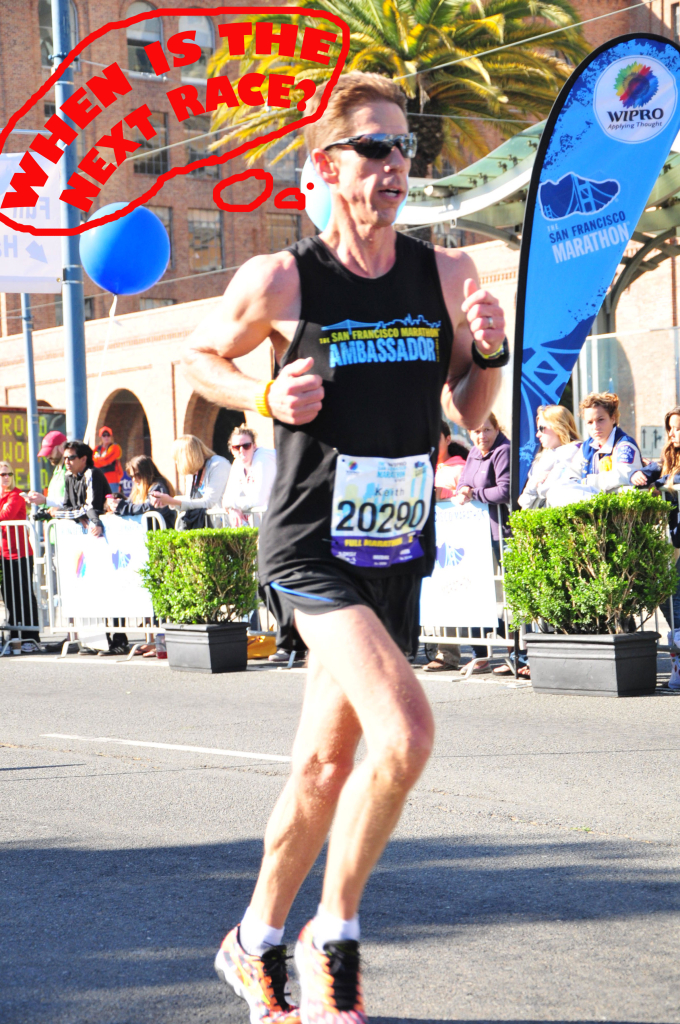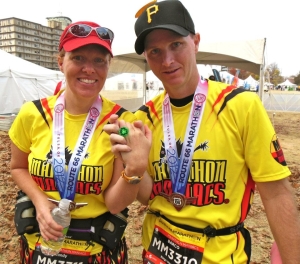After crossing the finish line, most marathon runners are ready for some rest and recovery. Numerous sources recommend at least one day per mile of recovery time before a runner returns to normal training. Many coaches suggest that runners compete in only one or two marathons per year.
 But there are some marathon runners who disagree with the common advice, and when they cross the finish line of one marathon they are already planning the next. ——>
But there are some marathon runners who disagree with the common advice, and when they cross the finish line of one marathon they are already planning the next. ——>
Frequent Marathoners are not as rare as you may think. They vary widely in running speed, body shape and size, economic status, and may be female or male. Some do it as a private personal quest, others promote themselves or run for charitable causes. The one common trait they share is a love for our sport, the marathon, and that common bond creates a strong community that ignores the differences and celebrates the marathon lifestyle.
Some Frequent Marathoners are members of a club called the “Marathon Maniacs“. They can be identified during races by their race kit – typically a yellow or pink singlet with the Maniacs logo. Total strangers become instant friends when they see a fellow Maniac. To join the Maniacs, a runner must first complete a series of marathons in a short period (many choose to run 3 within 90 days). Different “levels” are achieved by running more frequently. There are currently 8,600 Maniacs and more are joining every day.
It takes some commitment to train yourself to run marathons more often than once or twice a year. Fundamentally, the training really is not so different than “normal” – you must develop the ability to run for long periods of time, and you must run regularly. You also must learn your own body signals so that you can avoid injury. You need to establish nutritional and sleep habits that provide optimal recovery for your body. The truth is that there is little difference in training to run frequent marathons. However, you do need to throw away the typical 12-16 week marathon buildup training schedules and work on training more consistently at the same level that you might see in those plans in the later weeks. In other words, you will need to make it routine to do at least one long run every week. Those long runs should probably be at least 15 miles. Try racing frequently at shorter distances, from 5k to half-marathons, to teach your legs how to run when they are tired. On marathon race weeks, your marathon will serve as a long training run for future races. Between races, whether they are 24 hours, 1 week, or 1 month apart, you need to fuel your body properly. Replenish with plenty of carbs and proteins, and don’t be afraid of fat. Basically you should just plan to eat a lot. A lot of pizza is good 
One well-known Frequent Marathoner is Scot Barco. Last year, Barco ran 55 marathons in just 26 weeks. How does someone accomplish such a feat? It takes considerable planning and even some sacrifice. Many would say that running so many marathons is a recipe for injury, but according to Scot, after the 55th marathon, he “felt great. It wasn’t until I was not running as often that injury came”. Scot quit his job and went on the road for those 6 months, travelling from race to race and making friends along the way. He was running to test his limits, but he also paid attention to his health and sometimes made conscious decisions to pull back on his own effort and focus on encouraging first-timers.
Scot will tell you that his marathoning experience changed his life in many ways. One of the highlights of the series occurred at the Route 66 Marathon, where he proposed to his fiance’ in the middle of the race; they were subsequently married at mile 6 of the Honolulu Marathon. Scot’s wife Sandy is also a rather accomplished Frequent Marathoner. Scot and Sandy will both be running the San Francisco Marathon this July and are looking forward to encouraging runners there. Meanwhile, here are a few tips that Scot would like to share:
- There is time for fun during the run, but it’s also important to find time for fun between runs.
- Running 26.2 miles is great, but there is a greater experience all around you during the marathon; enjoy it!
- If you’re not nervous, you either don’t care or you are too confident. It’s good to be nervous about a marathon.
- Stick to the plan. For example, if you have a run/walk ratio planned, don’t change it mid-race.
- Do not be afraid of a DNF. Don’t injure yourself just because you’re not willing to pull back.
- You cannot compare yourself to somebody else. There is always somebody else who runs faster, or has run more marathons than you.
 If you’ve read this far, you may be interested in frequent marathoning. Most frequent marathoners will establish some sort of goal. You might want to run a marathon per month. Running a “Double” is a common goal – two marathons in two days. Some use the Marathon Maniacs levels as a source of goals, for example reaching the 10-star Titanium level. Groups exist for runners wishing to run all 50 states (The 50 States Marathon Club) or all 50 states in less than 4 hours each (The 50 Sub-4 Club). Marathoners like David Holmen have achieved a Boston-qualifying time in all 50 states. Other marathoners set their target on achieving 100 lifetime marathons, or 1,000…the possibilities are only limited by your imagination.
If you’ve read this far, you may be interested in frequent marathoning. Most frequent marathoners will establish some sort of goal. You might want to run a marathon per month. Running a “Double” is a common goal – two marathons in two days. Some use the Marathon Maniacs levels as a source of goals, for example reaching the 10-star Titanium level. Groups exist for runners wishing to run all 50 states (The 50 States Marathon Club) or all 50 states in less than 4 hours each (The 50 Sub-4 Club). Marathoners like David Holmen have achieved a Boston-qualifying time in all 50 states. Other marathoners set their target on achieving 100 lifetime marathons, or 1,000…the possibilities are only limited by your imagination.
Running for a cause is a popular reason for marathon running, and frequent marathoners are often involved in these fundraising efforts. Eddie Vega is currently on a quest to run all 50 states again – but this time, barefoot, in a charitable awareness campaign. Julie Weiss, The Marathon Goddess, recently ran 52 marathons in 52 weeks to raise funds and awareness for the fight against pancreatic cancer.
 Some frequent marathoners are on a quest to break records. The world record for most official marathons run in a year is held by Larry Macon, a 69-year old attorney who ran 255 marathons in 2013. The female record is held by Angela Tortorice who ran 129 marathons over 12 months last year.
Some frequent marathoners are on a quest to break records. The world record for most official marathons run in a year is held by Larry Macon, a 69-year old attorney who ran 255 marathons in 2013. The female record is held by Angela Tortorice who ran 129 marathons over 12 months last year.
There is also an annual ranking called “The Best Frequent Marathoners List“, as calculated by mathematician Dave Trautman, Ph.D. According to Dave, “This is an effort to identify those marathoners who a) run a lot of marathons, and b) run marathons fast. The emphasis is on being able to do both. There are some runners who can run a lot of marathons, and there are some runners who can run them much faster than the rest of us; I want to find those runners who can do both”.
Ultimately, you should only become a Frequent Marathoner if you truly love the sport. It’s fun to make the list, set a record, achieve a goal, or support a charity – but if the love of running long distances and testing your personal limits isn’t behind it, you won’t succeed. On the other hand, if you truly love the marathon, you’ll find that running them frequently leads to some wonderful experiences and life-long friendships.
Hope to see you at the next marathon, and many more to come!








